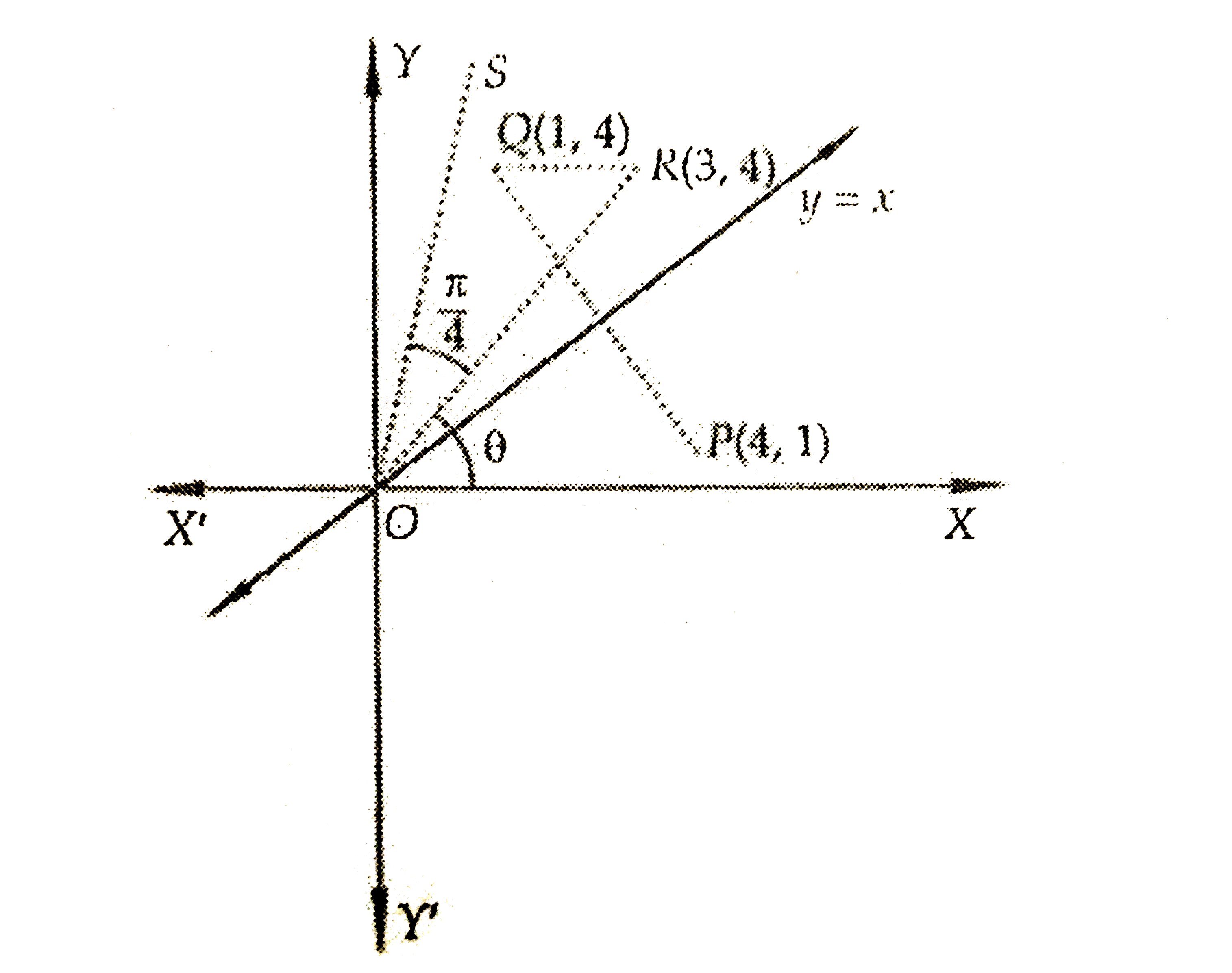The point (4,1) undergoes the following two successive transformations
(i) Reflection about the line y=x
(ii) Translation through a distance 2 units along the positive X-axis.
Then the final coordinate of the point are
(−1√2,7√2)
(−12,7√2)
(7√2,12)
none of these
The correct Answer is:B
Let Q be the reflection of P(4,1) about the line y=x . Then, the coordinates of Q are (1,4) the second transformation the point Q is translated through distance of 2 units along the positive direction of x-axis . Let the new position of Q be R. Then, the coordinates of R are (1+2,4) i.e. (3,4).
Suppose OR makes an angle θ with OX, Then,
tanθ=43,sinθ=45andcosθ=35
In the third transformation OR is rotated through π/4 in anticlockwise direction of coincide with OS. We have to find the co-ordinates of S.
Clearly , OR=OS .
∴OS=√32+42=5
OS makes angle (θ+π/4) with OX. So, the coordinates of S are
(OScos(θ+π/4),OSsin(θ+π/4))
or , (5(cosθ−sinθ√2),5(cosθ+sinθ√2)) or ,(−12,7√2)
Hence , the coordiantes of P in the final position are (−12,7√2.

Topper's Solved these Questions
Similar Questions
The point (4, 1) undergoes the following three transformations successively-
View SolutionThe point (4, 1) undergoes the following three transformations successively: (a) Reflection about the line y = x (b) Translation through a distance 2 units along the positive direction of the x-axis. (c) Rotation through an angle π4 about the origin in the anti clockwise direction. The final position of the point is given by the co-ordinates.
View Solution
Knowledge Check
The point (4,1) undergoes the following three transformations successively
(i) Reflection about the line y=x
(ii) Transformation through a distance 2 units along the positive direction of x-axis
(iii) Rotation through angle π/4 about the origin in the anticlockwise direction. The final position of the point is given by the coordinatesA(1√2,7√2)B(−2,7√2)C(−1√2,7√2)D(√2,7√2)The point (4,1) undergoes the following three successive transformations ,
reflection about the line y=x−1
translation through a distance 1 unit along the positive direction
rotation thrpough an angle π4 about the origin in the anti - clockwise direction
Then the coordinates of the final point are ,
A(4,3)B(72,72)C(0,3√2)D(3,4)The point P (a,b) undergoes the following three transformations successively :
(a) reflection about the line y = x.
(b) translation through 2 units along the positive direction of x-axis.
(c) rotation through angle π4 about the origin in the anti-clockwise direction.
If the co-ordinates of the final position of the point P are (−1√2,7√2) , then the value of 2a−b is equal to :A13B9C5D7
The point (3,2) undergoes the following three transformations in the order given (i) Reflection bout the line y=x (ii) Translation by the distance 1 unit in the positive direction of x-axis (iii) Rotation by an angle π4 about the origin
View SolutionThe point (1,3) undergoes the following transformations successively (i) Reflection with respect to the line y=x (ii) translation through 3 units along the positive direction of the X-axis (iii) Rotation through an angle π6 about the origin in the clockwise direction. The final position of the point P is
View SolutionThe point (3, 2) undergoes the following transformations successively
(i) Reflection with respect to the line y=x
(ii) translation through 3 units along the positive direction of the X-axis
(iii) Rotation through an angle of π6 about the origin in the clockwise direction. The final position of the point P is
View SolutionThe point A(4, 1) undergoes following transformations successively:reflection about line y=x translation ,through a distance of 3 units in the positive direction of x-axis(iii) rotation through an angle 105∘ in anti-clockwise direction about origin O.Then the final position of point A is
View SolutionThe point (2,3) is first reflected in the straight line y=x and then translated through a distance of 2 units along the positive direction of x-axis.The coordinates of the transformed point are
View Solution
